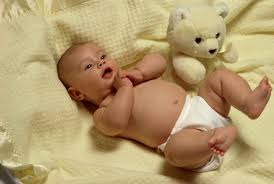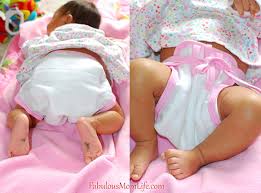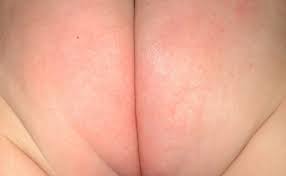
Vaatsalya Clinic
DIAPER DILEMMA
To Use A Diaper Or Not?

DISPOSABLE DIAPERS vs CLOTH DIAPERS?
Wondering about the best diaper for your newborn? Choosing a good-quality, absorbent diaper is key to protecting your new baby’s skin
There’s no clear winner in the diaper dilemma.
DISPOSABLE DIAPERS

PLUS POINTS
Disposables are easy; you just throw them away.
Traveling is easier with disposables.
Disposables are great for kids who have diarrhoea because these diapers don’t leak.
MINUS POINTS
Disposables don’t disintegrate — so they fill up landfills more.
Disposables can be expensive.
Using disposables may increase the time it takes to potty train your child because the little one can’t feel it when he’s wet.
CLOTH DIAPERS

PLUS POINTS
Cloth is more natural.
Cloth diapers now come with Velcro straps, so you don’t have to worry about safety pins.
Cloth diapers are less expensive than disposables.
MINUS POINTS
Cloth diapers use water and electricity to wash.
Cloth diapers must be rinsed out in the toilet, and you have to deal with the mess and the smell.
Cloth diapers leak more than disposables (even with the plastic outer pants).
Cloth diapers are not good for travel because you have to carry the used diapers with you.
The problems with both disposable and cloth diapers are that both can cause diaper rash equally, and both smell really bad after they’ve been used.
THE MIDDLE PATH AS THE DIAPER DILEMNA SOLUTION
One possible solution to the diaper dilemma is using a combination of cloth and disposable. Yes, that’s allowed! Use cloth diapers at home and then use disposable diapers for trips, outings to the store, when your child has diarrhoea, and possibly even for nap and bedtime.
Ultimately, parents are left to make their own personal choice. The American Academy of Paediatrics takes no position on cloth vs. disposable diapers.
DIAPERING YOUR BABY

You’ll probably decide before you bring your baby home whether you’ll use cloth or disposable diapers. Whichever you use, your little one will dirty diapers about 10 times a day, or about 70 times a week.
Before diapering your baby, make sure you have all supplies within reach so you won’t have to leave your infant unattended on the changing table. You’ll need:
- A clean diaper
- Safety pins (if cloth pre folded diapers are used)
- Diaper ointment if the baby has a rash
- A container of warm water
- A changing pad or cloth diaper for placing under your baby
- Clean washcloth, diaper wipes, or cotton balls
Make sure your supplies are all within reach. Babies should never be left unattended, even for a second. Even new-borns can surprise parents with their ability to roll.
Diaper changing might seem complicated at first. But with a little practice, you’ll find that keeping your baby clean and dry is easy.
After each bowel movement or if the diaper is wet, lay your baby on his or her back and remove the dirty diaper. Use the water, cotton balls, and washcloth or the wipes to gently wipe your baby’s genital area clean.

Wiping
Using the wet washcloth, cotton balls, or baby wipes, gently wipe your baby clean from the front to the back (never wipe from back to front, especially on girls, or you could spread the bacteria that can cause urinary tract infections). You might want to lift your baby’s legs by the ankles to get underneath. Don’t forget the creases in the thighs and buttocks.

For boys, keep a clean diaper over the penis during changing because exposure to air often causes boys to urinate — on you, the walls, or anything else within range.
Once you’ve finished wiping, pat your baby dry with a clean washcloth and apply diaper ointment.

Disposable Diapers
If you’re using disposable diapers:
Open the diaper and slide it under your baby while gently lifting his or her legs and feet. The back part with the adhesive strips should be about level with your baby’s bellybutton.
Bring the front part of the diaper up between your baby’s legs and onto his or her belly.
Bring the adhesive strips around and fasten snugly. Be careful not to stick the tape onto your baby’s skin.

Here are a few extra tips to keep in mind:
Garbage should be emptied regularly (about once a day) if you’re using disposables. This prevents a stinky diaper pail and the growth of bacteria.
If you find any marks around your baby’s legs and waist, the diaper is too tight. Go for a looser fit next time. If that doesn’t help, your baby may be ready for the next size diaper.
If a rash develops at the diaper openings around your baby’s leg and waist, change the brand of diaper you’re using. Sometimes babies become sensitive to certain brands of diapers.
If diapering a boy, place the penis in a downward position before fastening the diaper. This will help prevent leaks from creeping up above the waistline.
Fold down the waistline of the diaper if your baby’s umbilical cord has not fallen off yet to keep that area dry. Continue to do this for a few days after the cord has fallen off to prevent irritation.
Always wash your hands well after changing your baby’s diaper to prevent the spread of germs.

Cloth Diapers
Cloth diapers come in many shapes and sizes. Traditional cloth diapers usually come pre folded or in a square and require pinning. More modern types are fitted or contoured like disposable diapers, and come with Velcro stickings.
If you’re using traditional cloth diapers, there are several ways to fasten them. One of the more commonly used ways is the triangular fold:
Fold the square in half to form a triangle. (For newborns or smaller babies, you might need to fold the long side of the triangle down a few inches so it fits your baby better.)
Place your baby in the diaper by gently lifting the baby’s feet and legs and sliding the diaper under. The longest side of the triangle should be behind your baby’s back, with the opposite corner pointing down toward the feet.
Bring the front part of the diaper up between your baby’s legs and onto his or her belly.
Bring one side around so it overlaps the centre part.
Bring the other side around so it overlaps the other two parts. Fasten all three parts together with a safety pin.
Another method is the rectangular fold, which is similar to the fold of disposable diapers:
Fold the diaper into a rectangle. Some parents find it helpful to make an extra fold in the diaper so that extra material covers the area the baby will wet the most — in the front for a boy and on the bottom for a girl.
Position the diaper under your baby, with the long sides facing the same direction as your baby.
Bring the bottom up onto your baby’s belly.
Bring one side around and fasten with a safety pin, then do the same on the other side.

Here are some tips to keep in mind when using cloth diapers:
If using diapers that require pinning, use oversize pins with plastic safety heads. To prevent pricking the baby, keep your hand between the pin and his or her skin. If this makes you nervous, use diaper tape that comes in a dispenser.
Wet diapers can be tossed right into the diaper pail, but soiled diapers should be emptied into the toilet first — especially if your baby is formula-fed or on solids. Some people rinse the diaper before washing it. You may also choose to spray the diapers with water and baking soda for better odour control.
If you’re washing the diapers yourself, wash them separately from other laundry, using a mild detergent that is hypoallergenic or recommended for infant clothing. Don’t use fabric softener or antistatic products, which can cause rashes on babies’ sensitive skin. Use hot water and double rinse each wash.
Always wash your hands well after changing your baby’s diaper to prevent the spread of germs
DIAPER RASH
Diaper rash is a common concern. Typically the rash is red and bumpy and will go away in a few days with warm baths, some diaper cream, and a little time out of the diaper. Most rashes occur because the baby’s skin is sensitive and becomes irritated by the wet diaper.
To prevent or heal diaper rash, try these tips:
- Change your baby’s diaper frequently, and as soon as possible after bowel movements.
- After cleaning the area with mild soap and water or a wipe, apply a diaper rash or “barrier” cream. Creams with zinc oxide are preferred because they form a barrier against moisture.
- If you use cloth diapers, wash them in dye- and fragrance-free detergents.
- Let the baby go un diapered for part of the day. This gives the skin a chance to air out.

If the diaper rash continues for more than 3 days or seems to be getting worse, call your doctor — it may be caused by a fungal infection that requires a prescription.

When your baby is born, you’ll begin an entirely new phase of your life. Take the time during your baby’s first days to enjoy this new beginning…
© Vaatsalya Clinic. All rights reserved. Website Designed by Shaivali Joshi and Jimmy Thakkar.